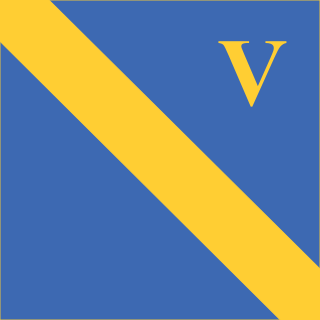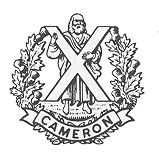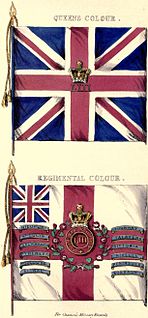
The 11th (Northern) Division, was an infantry division of the British Army during World War I, raised from men volunteering for Lord Kitchener's New Armies. The division fought in the Gallipoli Campaign and on the Western Front. The division's insignia was an ankh or ankhus.

The 52nd (Lowland) Infantry Division was an infantry division of the British Army that was originally formed as the Lowland Division, in 1908 as part of the Territorial Force. It later became the 52nd (Lowland) Division in 1915. The 52nd (Lowland) Division fought in the First World War before being disbanded, with the rest of the Territorial Force, in 1920. The Territorial Force was later reformed as the Territorial Army and the division was again raised, during the inter-war years, as the 52nd (Lowland) Infantry Division - a 1st Line Territorial Army Infantry Division - and went on to serve during the Second World War. After the war, the division was merged with the 51st (Highland) Infantry Division in 1948. The history of the division was carried on by the 52nd Lowland Brigade, and later the 52nd Lowland Regiment.

The 53rd (Welsh) Infantry Division was an infantry division of the British Army that fought in both World War I and World War II. Originally raised in 1908 as the Welsh Division, part of the Territorial Force (TF), the division saw service in World War I, being designated 53rd (Welsh) Division in mid-1915, and fought in the Gallipoli Campaign and in the Middle East. Remaining active in the Territorial Army (TA) during the interwar period as a peacetime formation, the division again saw action in World War II, fighting in North-western Europe from June 1944 until May 1945.

The 54th Infantry Division was an infantry division of the British Army. During the First World War the division fought at Gallipoli and in the Middle East. The division was disbanded after the war but reformed in the Territorial Army in 1920. During the Second World War it was a home service division and did not see any combat service abroad and was disbanded in late 1943 but many of its component units went to see service in the Normandy Campaign and North-western Europe from June 1944 to May 1945.

The 1st Infantry Division was a regular army infantry division of the British Army with a very long history. The division was present at the Peninsular War, the Crimean War, the First World War, and during the Second World War and was finally disbanded in 1960.
The 61st Division was an infantry division of the British Army raised in 1915 during the Great War as a second-line reserve for the first-line battalions of the 48th Division. However, the division was sent to the Western Front in May 1916 and served there for the duration of the First World War.

The 2nd Infantry Division was a Regular Army infantry division of the British Army, with a long history. Its existence as a permanently embodied formation dated from 1809, when it was established by Lieutenant General Sir Arthur Wellesley, as part of the Anglo-Portuguese Army, for service in the Peninsular War..

The 5th Infantry Division was a regular army infantry division of the British Army. It was established by Arthur Wellesley, 1st Duke of Wellington for service in the Peninsular War, as part of the Anglo-Portuguese Army, and was active for most of the period since, including the First World War and the Second World War and was disbanded soon after. The division was reformed in 1995 as an administrative division covering Wales and the English regions of West Midlands, East Midlands and East. Its headquarters were in Shrewsbury. It was disbanded on 1 April 2012.

The 7th Infantry Division was an infantry division of the British Army, first established by The Duke of Wellington as part of the Anglo-Portuguese Army for service in the Peninsular War, and was active also during the First World War from 1914–1919, and in the Second World War from 1938–1939 in Palestine and Egypt.

The 8th Infantry Division was an infantry division of the British Army that was active in both World War I and World War II. The division was first formed in October 1914 during World War I, initially consisting mainly of soldiers of the Regular Army and served on the Western Front throughout the war, sustaining many casualties, before disbandment in 1919. The division was reactivated in Palestine, under the command of Major-General Bernard Montgomery, in the late 1930s in the years running up to the Second World War before being disbanded in late February 1940. It was briefly reformed in Syria in an administrative role during 1942-3.
The 46th Division was an infantry division of the British Army, part of the Territorial Force, that saw service in World War I. At the outbreak of the war, the 46th Division was commanded by Major-General Hon. E.J. Montagu-Stuart-Wortley. Originally called the North Midland Division, it was redesignated as the 46th Division in May 1915.

The Egyptian Expeditionary Force (EEF) was a British Empire military formation, formed on 10 March 1916 under the command of General Archibald Murray from the Mediterranean Expeditionary Force and the Force in Egypt (1914–15), at the beginning of the Sinai and Palestine Campaign of the First World War.

The British Expeditionary Force order of battle 1914, as originally despatched to France in August and September 1914, at the beginning of World War I. The British Army prior to World War I traced its origins to the increasing demands of imperial expansion together with inefficiencies highlighted during the Crimean War, which led to the Cardwell and Childers Reforms of the late 19th century. These gave the British Army its modern shape, and defined its regimental system. The Haldane Reforms of 1907, formally created an Expeditionary force and the Territorial Force.
The 7th (Meerut) Division was an infantry division of the British Indian Army that saw active service during World War I.
The 3rd (Lahore) Division was an infantry division of the British Indian Army, first organised in 1852. It saw service during World War I as part of the Indian Corps in France before being moved to the Middle East where it fought against troops of the Ottoman Empire.

The 226th Infantry Brigade was a Home Service formation of the British Army that existed under various short-lived titles in both the First and Second World Wars.
221st Mixed Brigade was a Scottish Home Service formation of the British Army that served under various titles throughout World War I.
71st Division was a short-lived infantry division of the British Army during the First World War. It served in the Home Defence forces and never went overseas.
72nd Division was a short-lived infantry division of the British Army during World War I. It served in the Home Defence forces and never went overseas.
73rd Division was a short-lived infantry division of the British Army during World War I. It served in Home Forces and never went overseas.


























